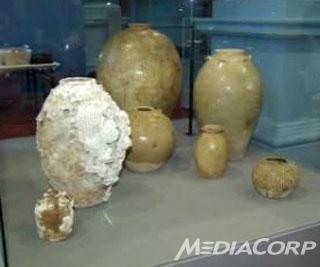ACM showcases Tang Dynasty artefacts from 9th century shipwreck
Sharon See
Source -http://www.channelnewsasia.com/stories/singaporelocalnews/view/1178506/1/.html
SINGAPORE: A tale of two kingdoms lost to the world for more than 1,200 years was uncovered from a shipwreck only some 14 years ago and these treasures from the Tang Dynasty are now being showcased at the Asian Civilisations Museum, including a few pieces never before seen by the world.
These treasures, which have been submerged in the ocean for 1,200 years, have now gotten a new look and some are encrusted with corals and barnacles.

Curator Kan Shuyi said: "When people look at some of these objects, they may feel that they look quite in pristine condition. That was partly because of the way they were packed. But these have actually been under the sea for actually a millennium. In a way, the marine encrustation added another kind of beauty to these objects."
The treasures, which include ceramics, gold and silverware, were recovered from a shipwreck found near Indonesia's Belitung Island in 1998.
VIDEO = http://www.channelnewsasia.com/video/index.php
They were on their way to the Middle East in a ninth-century Arab dhow before the ship sank.
On display at the Asian Civilisations Museum are some 130 artefacts and some of them are on display for the first time.
For instance, blue and white ceramic plates that are on display are the earliest intact examples of such ceramics ever found.
Ms Kan said: "Most people are familiar with blue and white ceramics that was introduced during the Yuan and Ming Dynasties. This is a much earlier predecessor that was really centuries before. In this exhibition, we've actually juxtaposed a blue and white from Iraq, from the Abbasid Empire against the Chinese blue and white because we see interactions in design and maybe in the form of the cobalt that was used."
And this is a sign that globalisation is not quite a recent concept.
Ms Kan added: "This Belitung ship is an early story of globalisation that we hope people will understand further, or realise that kind of connectivity that between the various cultures of the world in the past. Apart from Chinese wares, there are some objects from Southeast Asia that we can see that the ship may have come to Southeast Asia to pick up more goods or exchange some of these Chinese goods for things that were sought after, like spices and other rarities in Southeast Asia."
But even as these treasures are unearthed, there are more mysteries left unanswered.
Ms Kan said: "The other outstanding object that has never been shown to the public is a gilt silver flask. It's amazing for its size and the lush decoration it features and actually nothing of very similar design has been found in China at this point in time. And the group of gold, silver objects that has been found, which are the most precious items of the cargo actually shows that the merchants who were on the Belitung ship, or the owner of the ship, was actually in contact with the elites of Tang China because only the people in the highest social strata at that time were able to afford and actually use such objects so these were actually status objects.
"And that actually brings to mind even more interesting questions about who the people on the ship were dealing with, and maybe they were actually catering to different clientele by having such a big cargo with varying qualities of material."
After going through about 130 or so pieces on display, there is a small section that allows the public to get a feel literally of the Tang Dynasty, with their hands.
Ms Kan said: "Most of the time when people go to a museum, the things are behind glass cabinets and we thought it would be good if people can actually handle some of these objects and develop maybe another kind of appreciation for these ceramics as well because you can feel the form of the object, the potter inscribing words and the glaze."
The exhibition is at the Asian Civilisations Museum until June 17.